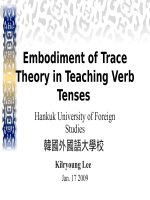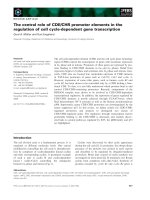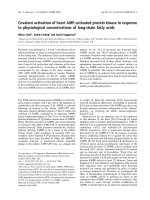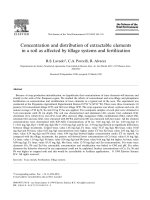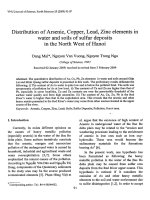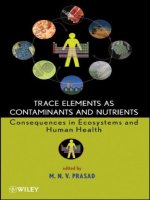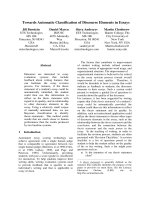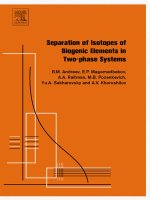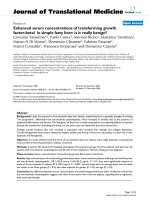Concentrations of trace elements in meretrix spp (mollusca bivalva) along the coasts of vietnam
Bạn đang xem bản rút gọn của tài liệu. Xem và tải ngay bản đầy đủ của tài liệu tại đây (53.9 KB, 4 trang )
Concentrations of trace elements in Meretrix spp.
(Mollusca: Bivalva) along the coasts of Vietnam
Tu N.P.C., Ha N.N., Agusa T., Ikemoto T., Tuyen B.C., Tanabe S.,
Takeuchi I.
Faculty of Agriculture, Department of Life Environment Conservation, Ehime University, Matsuyama,
Ehime 790-8566, Japan; Center for Marine Environmental Studies (CMES), Ehime University, Matsuyama,
Ehime 790-8577, Japan; Department of Legal Medicine, Shimane University Faculty of Medicine, Izumo,
Shimane 693-8501, Japan; Research Institute for Biotechnology and Environment (RIBE), Nong Lam
University, Thu Duc District, Hochiminh City, Viet Nam
Abstract: The dominant coastal bivalve in Vietnam, hard clams Meretrix spp., collected from the South Key
Economic Zone (SKEZ), the Mekong River Delta, and the Central Coastal Zone (CCZ) were analyzed for
21 trace elements. Comparison of the results from the three regions indicated that levels of most of the trace
elements, especially As, Mo, Sn, and Pb, were highest in the samples collected from the CCZ, whereas most
of the trace elements were found to be present at relatively low levels in samples from the SKEZ. The high
concentrations of these trace elements in the CCZ, a sparsely populated region with less human activity than
the other two regions, were believed to have originated from industrial waste produced in a shipyard.
Although the trace element concentrations in the bivalves were within safe levels for human-consumption
criteria reported by the United State Food and Drug Administration and the European Commission,
estimation of cancer risk based on As concentration indicates that the hard clams from the CCZ pose a high
risk to consumers. Thus, the industrial waste produced in the less densely populated region might increase
the health risk to consumers via the contamination of bivalves commonly used as food. © 2010 The
Japanese Society of Fisheries Science.
Author Keywords: Health risk; Meretrix; Shipyard waste; Trace element; Vietnam
Index Keywords: Bivalvia; Meretrix; Mollusca
Year: 2010
Source title: Fisheries Science
Volume: 76
Issue: 4
Page : 677-686
Link: Scorpus Link
Correspondence Address: Takeuchi, I.; Faculty of Agriculture, Department of Life Environment
Conservation, Ehime University, Matsuyama, Ehime 790-8566, Japan; email:
ISSN: 9199268
CODEN: FSCIE
DOI: 10.1007/s12562-010-0251-5
Language of Original Document: English
Abbreviated Source Title: Fisheries Science
Document Type: Article
Source: Scopus
Authors with affiliations:
1. Tu, N.P.C., Faculty of Agriculture, Department of Life Environment Conservation, Ehime University, Matsuyama, Ehime 7908566, Japan
2. Ha, N.N., Center for Marine Environmental Studies (CMES), Ehime University, Matsuyama, Ehime 790-8577, Japan
3. Agusa, T., Center for Marine Environmental Studies (CMES), Ehime University, Matsuyama, Ehime 790-8577, Japan,
Department of Legal Medicine, Shimane University Faculty of Medicine, Izumo, Shimane 693-8501, Japan
4. Ikemoto, T., Faculty of Agriculture, Department of Life Environment Conservation, Ehime University, Matsuyama, Ehime
790-8566, Japan
5. Tuyen, B.C., Research Institute for Biotechnology and Environment (RIBE), Nong Lam University, Thu Duc District,
Hochiminh City, Viet Nam
6. Tanabe, S., Center for Marine Environmental Studies (CMES), Ehime University, Matsuyama, Ehime 790-8577, Japan
7. Takeuchi, I., Faculty of Agriculture, Department of Life Environment Conservation, Ehime University, Matsuyama, Ehime
790-8566, Japan
References:
1.
(2004) Country Report on Land Based Pollution in Vietnam 2004, , MONRE (Vietnamese Ministry of Natural Resources and
Environment), Hanoi: MONRE
2.
Cenci, R.M., Martin, J.M., Concentration and fate of trace metals in Mekong River Delta (2004) Sci Total Environ, 332, pp.
167-182
3.
Tu, N.P.C., Ha, N.N., Ikemoto, T., Tuyen, B.C., Tanabe, S., Takeuchi, I., Bioaccumulation and distribution of trace elements
in tissues of giant river prawn Macrobrachium rosenbergii (Decapoda: Palaemonidae) from South Vietnam (2008) Fish Sci,
74, pp. 109-119
4.
Tu, N.P.C., Ha, N.N., Ikemoto, T., Tuyen, B.C., Tanabe, S., Takeuchi, I., Regional variations in trace element concentrations
in tissues of black tiger shrimp Penaeus monodon (Decapoda: Penaeidae) from South Vietnam (2008) Mar Pollut Bull, 57,
pp. 858-866
5.
Sudaryanto, A., Takahashi, S., Monirith, I., Ismail, A., Muchtar, M., Zheng, J., Richardson, B.J., Tanabe, S., Asia-Pacific
mussel watch: Monitoring of butyltin contamination in coastal waters of Asian developing countries (2002) Environ Toxicol
Chem, 21, pp. 2119-2130
6.
Monirith, I., Ueno, D., Takahashi, S., Nakata, H., Sudaryanto, A., Subramanian, A., Karuppiah, S., Tanabe, S., Asia-Pacific
mussel watch: Monitoring contamination of persistent organochlorine compounds in coastal waters of Asian countries (2003)
Mar Pollut Bull, 46, pp. 281-300
7.
Midorikawa, S., Arai, T., Harino, H., Ohji, M., Cu, N.D., Miyazaki, N., Concentrations of organotin compounds in sediment
and clams collected from coastal areas in Vietnam (2004) Environ Pollut, 131, pp. 401-408
8.
Nhan, D.D., Loan, D.T., Tolosa, I., de Mora, S.J., Occurrence of butyltin compounds in marine sediments and bivalves from
three harbour areas (Saigon, Da Nang and Hai Phong) in Vietnam (2005) Appl Organomet Chem, 19, pp. 811-818
9.
Boman, J., Wagner, A., Brauer, H., Binh, D.V., Trace elements in tissues from Vietnamese animals (2001) X Ray Spectrom,
30, pp. 388-392
10. Wagner, A., Boman, J., Biomonitoring of trace elements in Vietnamese freshwater mussels (2004) Spectrochim Acta B At
Spectrosc, 59, pp. 1125-1132
11. (2006) Guidelines for Environmental Management of Aquaculture Investments in Vietnam, , MOFI (Vietnamese Ministry of
Fisheries), Hanoi: MOFI
12. Han, B.C., Jeng, W.L., Chen, R.Y., Fang, G.T., Hung, T.C., Tseng, R.J., Estimation of target hazard quotients and potential
health risks for metals by consumption of seafood in Taiwan (1998) Arch Environ Contam Toxicol, 35, pp. 711-720
13. Wang, Y., Liang, L., Shi, J., Jiang, G., Study on the contamination of heavy metals and their correlations in mollusks
collected from coastal sites along the Chinese Bohai Sea (2005) Environ Int, 31, pp. 1103-1113
14. Abdullah, M.H., Sidi, J., Aris, A.Z., Heavy metals (Cd, Cu, Cr, Pb and Zn) in Meretrix meretrix Roding, water and sediments
from estuaries in Sabah, North Borneo (2007) Int J Sci Educ, 2, pp. 69-74
15. Liu, C.W., Liang, C.P., Lin, K.H., Jang, C.S., Wang, S.W., Huang, Y.K., Hsueh, Y.M., Bioaccumulation of arsenic
compounds in aquacultural clams Meretrix lusoria and assessment of potential carcinogenic risks to human health by
ingestion (2007) Chemosphere, 69, pp. 128-134
16. (2000) Guidance for Assessing Chemical Contaminant Data for Use in Fish Advisories: Risk Assessment and Fish
Consumption Limits, II. , US EPA3rd edn., Washington, DC: Office of Water
17. Storelli, M.M., Potential human health risks from metals (Hg, Cd, and Pb) and polychlorinated biphenyls (PCBs) via seafood
consumption: Estimation of target hazard quotients (THQs) and toxic equivalents (TEQs) (2008) Food Chem Toxicol, 46, pp.
2782-2788
18. Eisler, R., (1981) Trace Metal Concentrations in Marine Organisms, , New York: Pergamon Press
19. Boyden, C.R., Trace element content and body size in mollusks (1974) Nature, 251, pp. 311-314
20. Phillips, D.J.H., The common mussel Mytilus edulis as an indicator of pollution by zinc, cadmium, lead and copper. I.
Effects of environmental variables on uptake of metals (1976) Mar Biol, 38, pp. 59-69
21. Baldwin, S., Maher, W., Spatial and temporal variation of selenium concentration in five species of intertidal molluscs from
Jervis Bay, Australia (1997) Mar Environ Res, 44, pp. 243-262
22. Joiris, C.R., Azokwu, M.I., Heavy metals in the bivalve Anadara (Senilia) senilis from Nigeria (1999) Mar Pollut Bull, 38,
pp. 618-622
23. Riget, F., Johansen, P., Asmund, G., Influence of length on element concentrations in blue mussels (Mytilus edulis) (1996)
Mar Pollut Bull, 32, pp. 745-751
24. Sudaryanto, A., Takahashi, S., Iwata, H., Tanabe, S., Ismail, A., Contamination of butyltin compounds in Malaysian marine
environments (2004) Environ Pollut, 130, pp. 347-358
25. Bennett, R.F., Industrial manufacture and applications of tributyltin compounds (1996) Tributyltin: Case Study of an
Environmental Contaminant, pp. 21-61. , S. J. Morade (Ed.), Cambridge: Cambridge University Press
26. Champ, M.A., Economic and environmental impacts on ports and harbors from the convention to ban harmful marine antifouling systems (2003) Mar Pollut Bull, 46, pp. 935-940
27. Shim, W.J., Hong, S.H., Yim, U.H., Kim, N.S., Oh, J.R., Horizontal and vertical distribution of butyltin compounds in
sediments from shipyards in Korea (2002) Arch Environ Contam Toxicol, 43, pp. 277-283
28. Jackim, E., Morrison, G., Steele, R., Effects of environmental factors on radiocadmium uptake by four species of marine
bivalves (1977) Mar Biol, 40, pp. 303-308
29. Denton, G.R.W., Burdon-Jones, C., Influence of temperature and salinity on the uptake, distribution and depuration of
mercury, cadmium and lead by the black-lip oyster Saccostrea echinata (1981) Mar Biol, 64, pp. 317-326
30. Debenay, J.P., Luan, B.T., Foraminiferal assemblages and the confinement index as tools for assessment of saline intrusion
and human impact in the Mekong Delta and neighboring areas (Vietnam) (2006) Rev Micropaléontol, 49, pp. 74-85
31. Hung, T.C., Jeng, W.L., Ling, Y.C., Han, B.C., Distribution of heavy metals along the Machu/Taiwan-Minjiang/China
estuarine and coastal waters, sediments and bivalves (1998) Toxicol Environ Chem, 67, pp. 83-103
32. (2005) Guide for the Control of Molluscan Shellfish, , National Shellfish Sanitation Program, Washington, DC: US
Department of Health and Human Services, Food and Drug Administration, Center for Food Safety and Applied Nutrition
33. Schoof, R.A., Yager, J.W., Variation of total and speciated arsenic in commonly consumed fish and seafood (2007) Hum
Ecol Risk Assess, 13, pp. 946-965
34. Valette-Silver, N.J., Riedel, G.F., Crecelius, E.A., Windom, H., Smith, R.G., Dolvin, S.S., Elevated arsenic concentrations in
bivalves from the southeast coasts of the USA (1999) Mar Environ Res, 48, pp. 311-333
35. Macintosh, D.L., Spenglet, J.D., Özkaynak, H., Tsai, L.H., Ryan, P.B., Dietary exposure to selected metals and pesticides
(1996) Environ Health Perspect, 104, pp. 202-209
36. Han, B.C., Jeng, W.L., Hung, T.C., Ling, Y.C., Shieh, M.J., Chien, L.C., Estimation of metal and organochlorine pesticide
exposures and potential health threat by consumption of oysters in Taiwan (2000) Environ Pollut, 109, pp. 147-156
